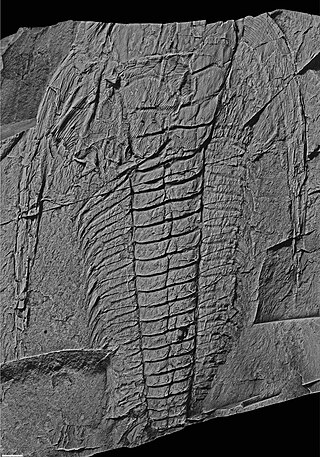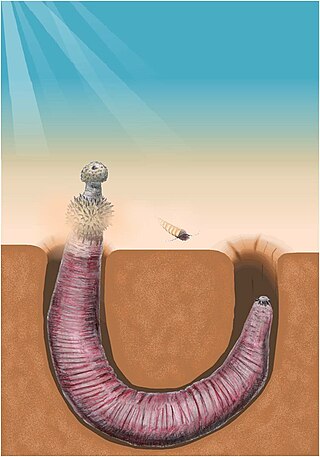
Charles Doolittle Walcott was an American paleontologist, administrator of the Smithsonian Institution from 1907 to 1927, and director of the United States Geological Survey. He is famous for his discovery in 1909 of well-preserved fossils, including some of the oldest soft-part imprints, in the Burgess Shale of British Columbia, Canada.

John William Salter was an English naturalist, geologist, and palaeontologist.

Volborthella is an animal of uncertain classification, whose fossils pre-date 530 million years ago. It has been considered for a period a cephalopod. However discoveries of more detailed fossils showed that Volborthella’s small, conical shell was not secreted but built from grains of the mineral silicon dioxide (silica), and that it was not divided into a series of compartments by septa as those of fossil shelled cephalopods and the living Nautilus are. This illusion was a result of the laminated texture of the organisms' tests. Therefore, Volborthella’s classification is now uncertain. It has been speculated that it may in fact represent a sclerite of a larger organism, on the basis of one specimen; however, it may be premature to accept this hypothesis, as the arrangement of sclerites producing this impression may have occurred by chance. The Ordovician scleritome-bearing Curviconophorus, as well as the Halwaxiids, lobopods and echinoderms, demonstrate the diversity of organisms which may produce a scleritome of this nature. The related Campitius was originally suggested to be part of a radula rather than a scleritome, but is now considered a synonym of Volborthella.

Archaeopriapulida is a group of priapulid worms known from Cambrian lagerstätte. The group is closely related to, and very similar to, the modern Priapulids. It is unclear whether it is mono- or polyphyletic. Despite a remarkable morphological similarity to their modern cousins, they fall outside of the priapulid crown group, which is not unambiguously represented in the fossil record until the Carboniferous. In addition to well-preserved body fossils, remains of several archaeopriapulid taxa are known to have been preserved primarily as organic microfossils, such as isolated scalids and pharyngeal teeth. They are probably closely related or paraphyletic to the palaeoscolecids; the relationship between these basal worms is somewhat unresolved.
The Walcott–Rust quarry, in Herkimer County, New York, is an excellent example of an obrution Lagerstätte. Unique preservation of trilobite appendages resulted from early consolidation (cementation) of the surrounding rock, followed by spar filling of the interior cavity within the appendages. The presence of so many well preserved trilobites in one location alone qualifies the beds as an exceptional trilobite site, but the beds are further distinguished as the source of the first trilobites for which appendages were definitively described.

The Burgess Shale, a series of fossil beds in the Canadian Rockies, was first noticed in 1886 by Richard McConnell of the Geological Survey of Canada (GSC). His and subsequent finds, all from the Mount Stephen area, came to the attention of palaeontologist Charles Doolittle Walcott, who in 1907 found time to reconnoitre the area. He opened a quarry in 1910 and in a series of field trips brought back 65,000 specimens, which he identified as Middle Cambrian in age. Due to the quantity of fossils and the pressures of his other duties at the Smithsonian Institution, Walcott was only able to publish a series of "preliminary" papers, in which he classified the fossils within taxa that were already established. In a series of visits beginning in 1924, Harvard University professor Percy Raymond collected further fossils from Walcott's quarry and higher up on Fossil Ridge, where slightly different fossils were preserved.

Vetulicola cuneata is a species of extinct animal from the Early Cambrian Chengjiang biota of China. It was described by Hou Xian-guang in 1987 from the Lower Cambrian Chiungchussu Formation, and became the first animal under an eponymous phylum Vetulicolia.
The Phyllopod bed, designated by USNM locality number 35k, is the most famous fossil-bearing member of the Burgess Shale fossil Lagerstätte. It was quarried by Charles Walcott from 1911–1917, and was the source of 95% of the fossils he collected during this time; tens of thousands of soft-bodied fossils representing over 150 genera have been recovered from the Phyllopod bed alone.
Leptomitus is a genus of demosponge known from the Middle Cambrian Burgess Shale. Its name is derived from the Greek lept ("slender") and mitos ("thread"), referring to the overall shape of the sponge. 138 specimens of Leptomitus are known from the Greater Phyllopod bed, where they comprise 0.26% of the community.

Fordilla is an extinct genus of early bivalves, one of two genera in the extinct family Fordillidae. The genus is known solely from Early Cambrian fossils found in North America, Greenland, Europe, the Middle East, and Asia. The genus currently contains three described species, Fordilla germanica, Fordilla sibirica, and the type species Fordilla troyensis.

Salterella is an enigmatic Cambrian genus with a small, conical, calcareous shell that appears to be septate, but is rather filled with stratified laminar deposits. The shell contains grains of sediment, which are obtained selectively by a manner also observed in foramanifera. The genus was established by Elkanah Billings in 1861, and was named after the English palaeontologist John William Salter.
Vologdinella is a poorly known genus of extinct animals of uncertain classification with small cylindrical shells. The animals are known from Middle Cambrian fossils from a Paleozoic limestone in the Chingiz Mountains of Kazakhstan. The genus was established by Russian paleontologist Zakhar Grigoryevich Balashov in 1962 for a single species, Vologdinella antiqua, which was originally described and illustrated as Orthoceras? antiquus by Aleksandr Grigoryevich Vologdin in 1931.

Fordillidae is an extinct family of early bivalves and one of two families in the extinct superfamily Fordilloidea. The family is known from fossils of early to middle Cambrian age found in North America, Greenland, Europe, the Middle East, Asia, and Australia. The family currently contains two genera, Fordilla and Pojetaia, each with up to three described species. Due to the size and age of the fossil specimens, Fordillidae species are included as part of the Turkish Small shelly fauna.

Fordilloidea is an extinct superfamily of early bivalves containing two described families, Fordillidae and Camyidae and the only superfamily in the order Fordillida. The superfamily is known from fossils of early to middle Cambrian age found in North America, Greenland, Europe, the Middle East, Asia, and Australia. Fordillidae currently contains two genera, Fordilla and Pojetaia each with up to three described species while Camyidae only contains a single genus Camya with one described species, Camya asy. Due to the size and age of the fossil specimens, Fordillidae species are included as part of the Turkish Small shelly fauna.
The Shady Dolomite is a geologic formation composed of marine sedimentary rocks of early Cambrian age. It outcrops along the eastern margin of the Blue Ridge province in the southeastern United States and can be found in outcrops in the states of Alabama, Georgia, Tennessee, North Carolina, and Virginia. It can also be found in the subsurface of Kentucky, Ohio, and West Virginia. The Shady is predominantly composed of dolomite and limestone with lesser amounts of mudrock. It contains fossils of trilobites, archaeocyathids, algae, brachiopods, and echinoderms, along with the enigmatic fossil Salterella. The Shady Dolomite was first described by Arthur Keith in 1903 and was named for exposures in the Shady Valley of Johnson County in the state of Tennessee. Near Austinville, Virginia, the Shady hosts ore deposits that have been mined extensively for lead and zinc ore.

The Vintage Dolomite is a geologic formation in Pennsylvania. It preserves fossils dating back to the Cambrian period.
The Mount Whyte Formation is a stratigraphic unit that is present on the western edge of the Western Canada Sedimentary Basin in the southern Canadian Rockies and the adjacent southwestern Alberta plains. It was deposited during Middle Cambrian time and consists of shale interbedded with other siliciclastic rock types and limestones. It was named for Mount Whyte in Banff National Park by Charles Doolittle Walcott, the discoverer of the Burgess shale fossils, and it includes several genera of fossil trilobites.

Agmata is a proposed extinct phylum of small animals with a calcareous conical shell. They were originally thought to be cephalopods or annelid worms. The living animals filled up to five-sixths of their shell with laminae, angled layers composed of grains of quartz or calcium carbonate detritus from the environment cemented together, with larger grains near the shell wall and smaller grains near the center. A very fine tube ran through the center of the shell. The grains may be of quartz or calcium carbonate, but are of specific shapes and materials that are rare in the surrounding rock. Though the body of the living animal is not preserved, it had to be able to find, choose, and retrieve rare grains from its environment to build the laminae.
Ellisell is a Middle Cambrian genus of fossils from Denmark. It contains only one species, Ellisell yochelsoni. Both the genus and species are named after the paleontologist and geologist Ellis L. Yochelson (1928–2006), who had turned 60 at the time the fossils were first described. The genus was originally placed in the family Salterellidae of the phylum Agmata; this placement was rejected by Yochelson & Kisselev (2003), but was restored by Peel (2016). Ellisell is distinguished from Salterella by its slowly expanding conch and the resulting cylindrical apertural cavity, compared to the latter's more rapidly expanding conch and cone-shaped apertural cavity.
The Cambrian chordates are an extinct group of animals belonging to the phylum Chordata that lived during the Cambrian, between 485 and 538 million years ago. The first Cambrian chordate known is Pikaia gracilens, a lancelet-like animal from the Burgess Shale in British Columbia, Canada. The discoverer, Charles Doolittle Walcott, described it as a kind of worm (annelid) in 1911, but it was later identified as a chordate. Subsequent discoveries of other Cambrian fossils from the Burgess Shale in 1991, and from the Chengjiang biota of China in 1991, which were later found to be of chordates, several Cambrian chordates are known, with some fossils considered as putative chordates.










